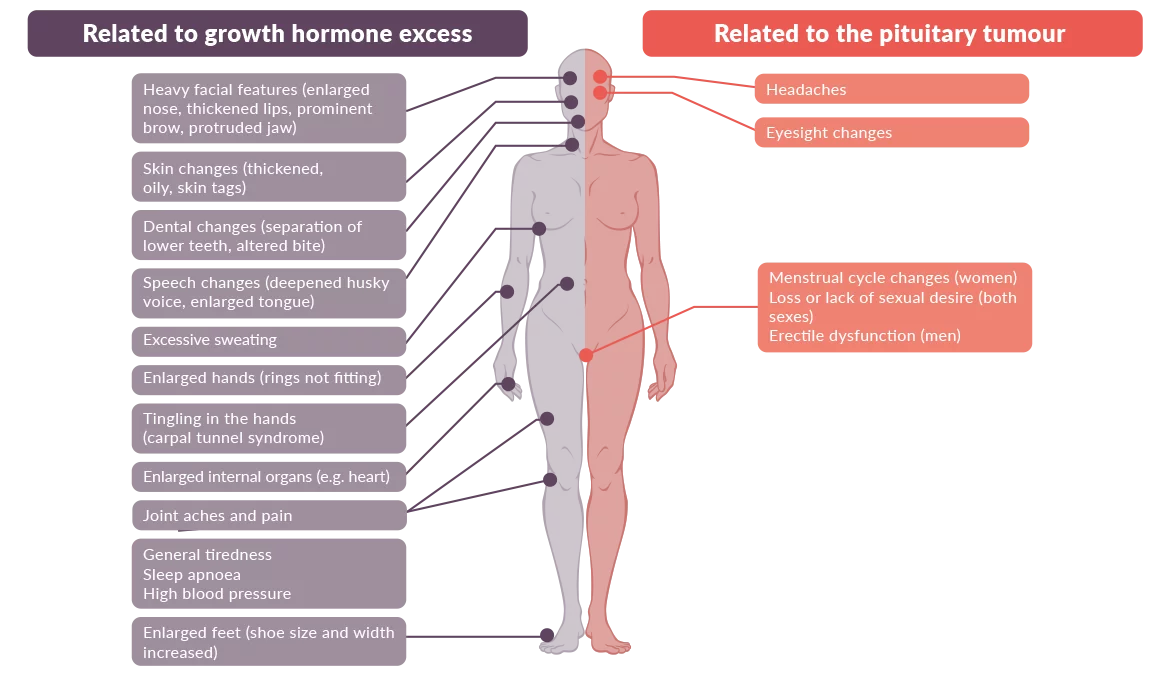What Are the Symptoms of Acromegaly?
Symptoms of acromegaly take time to develop in adults. The most common sign of acromegaly is enlarged face, hands, and feet. People with this rare endocrine disorder will find that their shoe size may increase over time throughout adulthood and their rings no longer fit like they used to. Acromegaly is very rare in children, but leads to a condition called gigantism where the child will grow exponentially larger than normal.
People with acromegaly will find that their shoe size increases over time throughout adulthood and their rings no longer fit like they used to. It is very rare in children, presenting as a condition called gigantism where the child will grow exponentially larger than normal.
Since we look at ourselves daily, recognizing this rare disease can be challenging making detection challenging. The most easily recognizable signs of acromegaly are gradual changes in the shape of your face, such as a protruding lower jaw and brow, an enlarged nose, thickened lips, and wider spacing between your teeth.
Acromegaly usually develops slowly, early signs may not be obvious for years. Even your family members may not initially notice the gradual physical changes that occur with this disorder, but early diagnosis is important so that you can start getting proper care. Acromegaly can lead to serious complications if it’s not treated.
Symptoms vary from one person to another, but these are the most common symptoms.
- a large jaw and tongue
- gaps between the teeth
- a more prominent brow
- swollen hands
- large feet
- rough and oily skin
- numb hands and feet
- tingling in hands and feet
- heavy sweating
- headaches
- a deeper voice
- impaired vision
- skin tags
- low sex drive
When to see a doctor
If you have any symptoms associated with acromegaly, contact your doctor for an evaluation.
In addition to physical symptoms, living with a rare disease can be emotionally very traumatic. Symptoms such as loss of libido, exhaustion and changing body image can be stressful, particularly as there may be some time before correct diagnosis and discussion of treatment. Even after this, anxiety about anticipated surgery so close to the brain and an understanding that recovery can take a while for some people can be difficult to cope with.
Acromegaly symptoms checklist
If you suspect you have any symptoms or signs of acromegaly, here is a checklist you can use to discuss with your healthcare provider.
Managing Acromegaly Symptoms
Caring for acromegaly involves so much more than blood work. Communicating how acromegaly affects your quality of life may be challenging, but this information is important for your health care team to ensure they are addressing all aspects of your disease.
This symptom tracker may be a useful way to document your symptoms and serve as a reference at your next appointment. This is a tool to help you to prepare for your next appointment and is not intended to serve as medical advice. If at any time you experience severe symptoms, immediately contact your physician.
Download the Acromegaly Symptom Tracker
References:
National Library of Medicine (1996, October 18) Real-world Comorbidities and Treatment Patterns of Patients With Acromegaly in Two Large US Health Plan Databases [Website]. Retrieved May 2020.
National Library of Medicine (1996, October 18) Patterns of Pharmacologic Treatment in US Patients With Acromegaly [Website]. Retrieved June 2020.
Acromegaly Care (2015, November 02) Managing Symptoms – Acromegaly Care [Website]. Retrieved April 2020.

